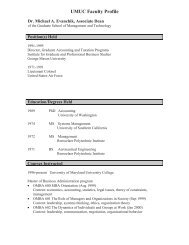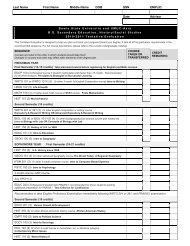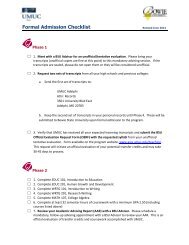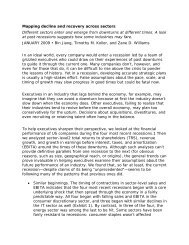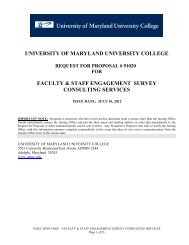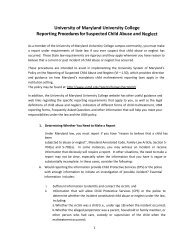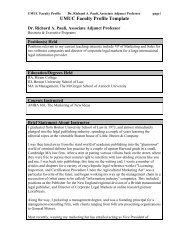A+B. Intro_SJ.1 - University of Maryland University College
A+B. Intro_SJ.1 - University of Maryland University College
A+B. Intro_SJ.1 - University of Maryland University College
Create successful ePaper yourself
Turn your PDF publications into a flip-book with our unique Google optimized e-Paper software.
PRPA 604 Public Relations Law and Ethics (3)<br />
This course surveys communications law emphasizing its applications<br />
to advertising and public relations. Topics include First<br />
Amendment issues, libel, privacy, confidentiality, and access to<br />
information. Ethical issues surrounding the practice <strong>of</strong> public<br />
relations in a wired world will be explored.<br />
PRPA 610 Crisis Management Seminar (3)<br />
This seminar examines current approaches to defining crises,<br />
issue management, and crisis management through a mix <strong>of</strong><br />
discussion, lecture, and presentation. Students will explore traditional<br />
and Web-based approaches to the study <strong>of</strong> issue management<br />
and crisis management by applying research, theory, and<br />
case examples to these situations with a goal <strong>of</strong> developing better<br />
issue identification, public segmentation, and strategic response<br />
sets to crisis situations.<br />
TLMN 602 Telecommunications Industry: Structure and<br />
Environment (3)<br />
Major technological, legal, and re g u l a t o ry developments (national<br />
and international) are studied as they have molded the stru c t u re<br />
<strong>of</strong> the current telecommunications industry. The course traces the<br />
p ro g ression <strong>of</strong> early legislation, the regulated monopoly, antitru s t ,<br />
d i ve s t i t u re, and recent legislation that has led to the current indust<br />
ry environment <strong>of</strong> competition and incipient integration <strong>of</strong><br />
different industry segments. The roles <strong>of</strong> various national and<br />
international institutions in shaping the telecommunications<br />
industry are discussed.<br />
TLMN 610 Data Communications Systems (3)<br />
Prerequisites: Statistics and Calculus I, or equivalent. This<br />
course covers the technology underlying data communications<br />
systems, such as transmission media, modulation and demodulation,<br />
multiplexing, packet switching, hardware, s<strong>of</strong>tware, and<br />
network operations. Topics include fiber optics, the Integrated<br />
Services Digital Network (ISDN), T-1 and T-3 multiplexers,<br />
the open systems interconnection (OSI) model, and integrated<br />
voice-data equipment. Methods for determining system requirements<br />
as well as approaches to system design are covered in light<br />
<strong>of</strong> current data communications equipment, applications, and<br />
services and their future trends.<br />
TLMN 620 Local Area Networking Systems (3)<br />
Pre requisites: Statistics and Calculus I, or equivalent. This course<br />
examines the design, implementation, and management <strong>of</strong> computer<br />
networking systems. It examines the seve n - l a yer Op e n<br />
Systems In t e rconnection (OSI) re f e rence model. Ne t w o rk i n g<br />
methods for local area networking (LAN) such as Ethernet and<br />
Token Ring are studied along with enterprise network technologies<br />
such as Fiber Distributed Data In t e rface (FDDI). Also examined<br />
are LAN devices such as repeaters, bridges, routers, hubs, and<br />
g a t eways. Traffic engineering techniques in networks are analyze d<br />
and evaluated. Various distributed computing arc h i t e c t u res and<br />
emerging trends in the supporting technologies are central to<br />
course content. Topical discussions and case studies re i n f o rce and<br />
s y n t h e s i ze new-found principles and provide the means for practical<br />
application <strong>of</strong> abstract concepts. Each session includes eva l u a-<br />
tion methodologies re l e vant to strategic and economic planning.<br />
TLMN 625 Wide Area Networking Systems (3)<br />
Prerequisites: Statistics and Calculus I, or equivalent. This<br />
course discusses transmission and switching for wide area networks<br />
(WAN), including circuit switched networks, such as<br />
the Public Switched Telephone Network (PSTN), and packet<br />
networks, such as the Internet. Other topics include Common-<br />
Channel Inter<strong>of</strong>fice Signaling (CCIS), Signaling System 7 (SS7),<br />
frame relay, and asynchronous transfer mode (ATM). Audio and<br />
video compression techniques are examined. Also studied are<br />
Private Branch Exchanges (PBX) including computer-telephone<br />
integration (CTI). A review is made <strong>of</strong> current trends including<br />
voice over Internet Protocol (IP).<br />
TLMN 630 Satellite Communication Systems (3)<br />
Pre requisites: Statistics and Calculus I, or equivalent. This course<br />
analyzes issues surrounding the current and future design and<br />
use <strong>of</strong> satellite communications systems. Topics include such<br />
satellite system characteristics as type, class (bandwidth, standards,<br />
and availability), applications, interfaces, traffic patterns,<br />
network installation, performance criteria, hardware, and cost.<br />
Current and planned satellite communications are examined<br />
and compared to future needs and technologies.<br />
w w w. u m u c . e d u / g r a d<br />
Un i versity <strong>of</strong> Ma r yland Un i versity <strong>College</strong> | 145 |





